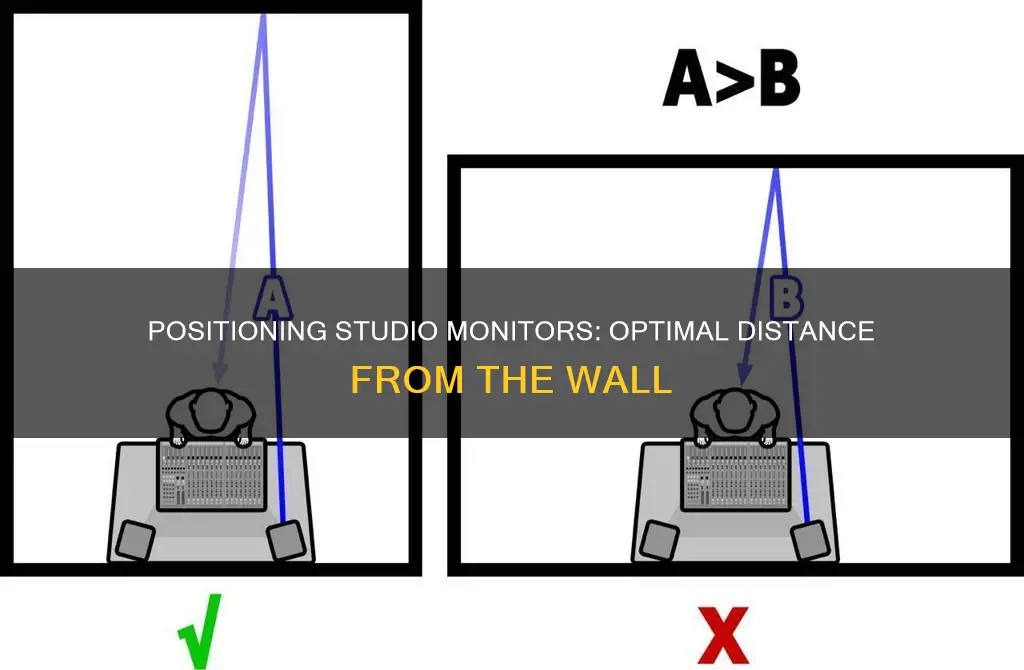
The placement of studio monitors is critical to achieving optimal sound quality and accuracy. While it may be tempting to place them against the wall to maximise space, this can cause a boost in low frequencies of up to 6dB, resulting in bass buildup. The ideal distance between studio monitors and the wall depends on various factors, including room size, speaker size, and the presence of ports or rear-porting. A general guideline is to maintain a minimum distance of 6-10 inches, with 2-3 feet being preferable. Placing the monitors within 44-60 centimetres of the wall can help avoid sound cancellation and opposite waves. Additionally, the angle, height, and surface on which the monitors are placed are crucial considerations to achieve the desired sound accuracy and imaging.
| Characteristics | Values |
|---|---|
| Distance from the wall | 6-10 inches, 2-3 feet or 43 inches (110cm) away from the wall are recommended by different sources. |
| Distance between speakers | The distance between the speakers should be the same as the distance from each speaker to the listener's ears. |
| Height | Ideally, the tweeters should be at the same height as the listener's ears when seated, which is typically about 47-55 inches (120-140 cm) from the floor. |
What You'll Learn
- Studio monitors should be placed at least 5-60cm from walls to avoid sound cancellation
- Placing monitors against walls or corners can cause a bass buildup
- Monitors should be placed at ear level or slightly above to direct sound towards the ears
- Speakers should be placed on stands to avoid early reflections from the desk
- The ideal listening position is somewhere between 30-40% of the distance between the front and back walls

Studio monitors should be placed at least 5-60cm from walls to avoid sound cancellation
Studio monitors are the crux of any recording studio, and their placement is key to ensuring consistent results from your mixes. One of the most important factors to consider is how far to place them from the walls of your studio.
The distance you place your studio monitors from the rear wall can dramatically alter the quality of sound. When the gap between the monitor and the wall is such that the reflected audio cancels the audio from the monitor, you get a phase cancellation problem that reduces the volume of bass in your listening position. This problem cannot be fixed by equalization.
The ideal distance between studio monitors and walls depends on the size of the room and the placement of the listener. The general rule of thumb is to keep free space around the monitors at a ratio of around one-quarter to one-third relative to the distance between the front of the speakers and the listener. For example, if your speakers are 2m away from the listening position, there should be around 50-66cm of free space to the sides and the wall behind.
To avoid sound cancellation, studio monitors should be placed at least 5-60cm from walls. This will ensure that the low-frequency output is not cancelled in your seated monitoring position, resulting in a more balanced, highly focused, and better-imagined listening position.
However, it is important to note that placing studio monitors too close to the wall can also boost the low frequencies by up to 3dB, making your mixes sound huge, but when you take them outside of your room, they will lack bass. Therefore, it is recommended to place the speakers a minimum of 6 to 10 inches away from the wall, with 2-3 feet being better to minimize bass buildup from the front wall.
Performance Management: Strategies for Organizational Success
You may want to see also

Placing monitors against walls or corners can cause a bass buildup
The placement of studio monitors is critical to achieving consistent results from your mixes. Placing studio monitors against walls or corners can cause a bass buildup, resulting in an inaccurate representation of your audio. This is due to the reinforcement of bass frequencies caused by the proximity of the walls.
When studio monitors are placed close to a wall, the bass response is exaggerated by up to 6dB. This is because the low-end bass frequencies radiate in all directions, and when they hit the wall, they bounce back, mix with the direct speaker sound, and cause phase cancellation, reducing the volume of bass in your listening position. This problem is further exacerbated when monitors are placed in corners, as the soundwaves interact differently, causing an uneven frequency distribution.
To mitigate this issue, it is recommended to place studio monitors either almost against the wall or at least 43 inches (110 cm) away. If your speakers have a rear port, maintain a distance of at least 5 to 10 cm from the wall. Speakers placed between 15 and 44 inches (38-110 cm) from the wall can create uneven bass responses due to low-frequency reflections.
If your studio setup requires you to place monitors near a wall or corner, there are a few solutions to reduce bass buildup. One option is to use the quarter-space EQ setting on your speakers, which helps mitigate extra bass buildup. Additionally, placing absorbers on the surface behind the monitors can help trap some reflections. Another solution is to use Soffit Mounting, where the monitor is built into the wall cavity, eliminating the wall and reducing cancellations.
It is important to note that placing monitors too far from the wall, such as in the centre of the room, can also cause issues. This can over-excite standing waves in the space, making the sound less reliable. Therefore, it is recommended to maintain a balance and follow the guidelines provided above for optimal studio monitor placement.
Disabling Your HP LCD Monitor: A Step-by-Step Guide
You may want to see also

Monitors should be placed at ear level or slightly above to direct sound towards the ears
The placement of your studio monitors is crucial to achieving a balanced soundstage and accurate stereo imaging. One of the key considerations is the height of the monitors relative to your ears. Ideally, the monitors should be placed at ear level or slightly above to direct the sound towards your ears and reduce unwanted reflections from other surfaces.
When setting up your studio monitors, it is recommended to form an equilateral triangle with the monitors and your listening position. This means that the distance between the left and right speakers and the distance from each speaker to your head should be equal. By doing this, you can achieve a natural stereo "sweet spot", allowing you to move around slightly while still maintaining optimal sound quality.
The height of the monitors is an important factor in achieving this optimal sound experience. Placing the monitors at ear level or slightly above ensures that the sound is directed accurately towards your ears. This setup minimises the high frequencies that bounce off the side walls, providing a clearer and more precise stereo image. Additionally, it helps to reduce unwanted reflections from other surfaces, such as your desk or the walls behind the monitors.
To achieve the ideal height, you can adjust the height of your monitor stands or consider using height-adjustable stands. This will allow you to fine-tune the placement of your monitors to ensure they are at the perfect height relative to your ears. If your monitors are placed on a desk, you may need to raise the surface to an uncomfortably high level to align the speakers with your ears. In this case, using monitor stands or placing the monitors on a higher platform can be a more suitable solution.
By following these guidelines and placing your studio monitors at ear level or slightly above, you can optimise the sound quality and create a more accurate and immersive listening experience.
Taiwan's Utilities: Monitoring Residential Peak Usage?
You may want to see also

Speakers should be placed on stands to avoid early reflections from the desk
The placement of studio monitors is crucial to achieving optimal sound quality. One of the factors that can affect the sound is the distance between the monitors and the rear wall. When the monitors are too close to the wall, the wall reflection interferes with the direct sound from the monitor, resulting in phase cancellation and reduced bass volume.
To avoid this issue, it is recommended to place the studio monitors as close as possible to the rear wall, ideally within 60 centimetres. If the speakers are on stands, move the stands as close to the wall as possible. This ensures that the low-frequency output is not cancelled when you are seated in the monitoring position.
Now, let's discuss why speakers should be placed on stands to avoid early reflections from the desk:
Speakers should ideally be placed on stands to elevate them above the desk surface. This helps to direct the sound towards your ears and creates a more natural stereo image. The stands also provide some distance between the speakers and the desk, reducing the impact of early reflections from the desk surface. Reflections from the desk can interfere with the direct sound, causing phase issues and affecting the accuracy of the stereo image.
By placing the speakers on stands, you create a more optimal listening position, allowing for a wider ""sweet spot" where you can move around while still experiencing clear and accurate sound. The stands also help to minimise high frequencies that bounce off the sidewalls, as the speakers can be angled directly towards your ears.
In addition, speaker stands can provide isolation from vibrations. When speakers are placed directly on a desk, the desk may vibrate along with the speakers, resulting in a loss of volume or the resonance of unwanted frequencies. Speaker stands, especially those with isolation pads or shock absorbers, can eliminate these problems and improve the overall sound quality.
Furthermore, stands provide flexibility in positioning the speakers. If your room has limitations, such as a small desk or a nearby sidewall, stands can help you achieve the optimal geometry for your setup. You can adjust the height and angle of the speakers to ensure they are directed slightly behind your head, which is ideal for studio monitoring.
In summary, placing studio monitors on stands helps to avoid early reflections from the desk, improves sound quality, and provides a more flexible setup. By reducing reflections and isolating vibrations, you can achieve a more accurate and immersive listening experience.
Asus Monitors: What Cables Are Included?
You may want to see also

The ideal listening position is somewhere between 30-40% of the distance between the front and back walls
In a rectangular room, this means facing the shortest wall, equidistant from the left and right walls (the longer walls). For example, if your room is 10 feet by 12 feet, the listening position should be five feet away from each of the side walls (centred on the short wall) and somewhere in the neighbourhood of 3.5 to 4 feet from the front wall (30-40% of the long wall length).
The equidistant placement of the speakers in relation to the listener is known as the equilateral triangle setup. This is a crucial element of studio monitor placement, helping to create an accurate stereo image. When speakers are placed at an equal distance from the listener, it assists in achieving a balanced soundstage where the left and right channels present a clear and precise stereo image.
The equilateral triangle setup also establishes an optimal "sweet spot" for monitoring. The listener's position at the apex of the triangle allows them to experience the most accurate representation of the audio being played. This setup also minimises phase issues and discrepancies in frequency response.
The ideal height for the monitors is at ear level or slightly above. This helps direct the sound accurately towards your ears, reducing unwanted reflections from surfaces.
Recognizing a CRT Monitor's Demise: Signs to Look For
You may want to see also
Frequently asked questions
Studio monitors should be placed at least 6 to 10 inches away from the wall, with 2-3 feet being ideal. This will minimize bass buildup from the wall. However, if your speakers have a rear port, maintain a distance of at least 5 to 10 centimeters from the wall.
The ideal setup is to form an equilateral triangle, with the distance between the speakers being the same as the distance from each speaker to the listener's head. This ensures a balanced soundstage and an optimal "sweet spot" for monitoring.
Placing studio monitors in a corner can lead to a buildup of low-frequency energy due to the reinforcement of bass frequencies caused by the proximity of the walls. This results in an uneven frequency response, with low frequencies becoming boomy or overpowering. It can also cause imbalanced stereo imaging and increase the likelihood of sound reflections and phase cancellation issues.







